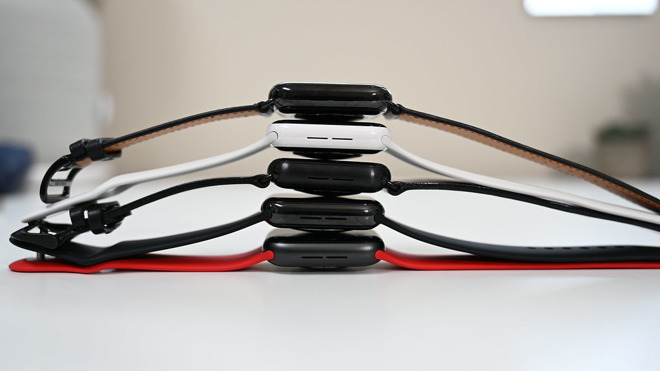Apple Watch 'Series 6' could use smaller batteries than Series 5
The Apple Watch Series 6 may have a comparable or shorter battery life compared to previous models, with regulatory filings indicating there could be three different sizes of battery used, with two out of the three smaller than the last generation and one larger.

Apple Watch collection
Apple's refinements with the Apple Watch series have led to wearable devices that are more power-efficient, extending their battery life as much as possible to get users though the day. Initial regulatory filings relating to the next model suggest Apple may be leaning on its power efficiency improvements.
Filings with 3D, Safety Korea, and UL Demco seen by MySmartPrice reveal a trio of batteries submitted by Apple for use in the Apple Watch Series 6. The filings, which includes photographs of the components, reveal three model numbers for the batteries: A2306, A2345, and A2327.
The three batteries have differing capacities, with the A2327 having the largest capacity at 303.8mAh. The A2345 and A2306 have lower capacities of 265.9mAh and 262.9mAh respectively.
The differing capacities could be for a few reasons, such as for different sizes of models, or for versions with LTE over models without cellular connectivity.
The capacities may have an impact on the battery life of the Series 6, as two out of the three are smaller than the battery used in the Apple Watch Series 5, which had 296mAh, and the Apple Watch Series 4 at 291.8mAh.
Depending on Apple's power-saving gains for the next generation, there is a good chance that it may offer the same battery life as the Series 5 at least, though the larger capacity model stands a chance of offering more time between charges.
Other rumors circulating about the Apple Watch Series 6 has the device including a new plastic option, the possible use of microLED, and increased wireless performance.

Apple Watch collection
Apple's refinements with the Apple Watch series have led to wearable devices that are more power-efficient, extending their battery life as much as possible to get users though the day. Initial regulatory filings relating to the next model suggest Apple may be leaning on its power efficiency improvements.
Filings with 3D, Safety Korea, and UL Demco seen by MySmartPrice reveal a trio of batteries submitted by Apple for use in the Apple Watch Series 6. The filings, which includes photographs of the components, reveal three model numbers for the batteries: A2306, A2345, and A2327.
The three batteries have differing capacities, with the A2327 having the largest capacity at 303.8mAh. The A2345 and A2306 have lower capacities of 265.9mAh and 262.9mAh respectively.
The differing capacities could be for a few reasons, such as for different sizes of models, or for versions with LTE over models without cellular connectivity.
The capacities may have an impact on the battery life of the Series 6, as two out of the three are smaller than the battery used in the Apple Watch Series 5, which had 296mAh, and the Apple Watch Series 4 at 291.8mAh.
Depending on Apple's power-saving gains for the next generation, there is a good chance that it may offer the same battery life as the Series 5 at least, though the larger capacity model stands a chance of offering more time between charges.
Other rumors circulating about the Apple Watch Series 6 has the device including a new plastic option, the possible use of microLED, and increased wireless performance.

Comments
I’d love my Apple Watch to last longer, but that does not seem a priority to Apple for some reason.
Why do Apple haters always think like 1980?
The rumored oximeter in the Series 6 could be a different tier Watch and require a bigger battery. It's not that it monitors O2 all day long, but it's one more feature some people will be using, possibly throughout the day.
Apple might be doing different tiers within the basic Series 6, or they might be relegating some additional functionality to different Editions.
With the always on screen active, my own Series 5/LTE runs into the red zone on the evening of the second day. In effect, assuming overnight charging, this means needing to charge it every day.
But with the screen set to turn on/off automatically — which from an appearance point of view I actually prefer — there's still 30-35% left in the battery at the end of day 2. So now it's only on the charger every second night, and that's with some considerable margin for extra usage. Even the heaviest user should easily get through a full 16+ hour waking day.
I think that's pretty good.